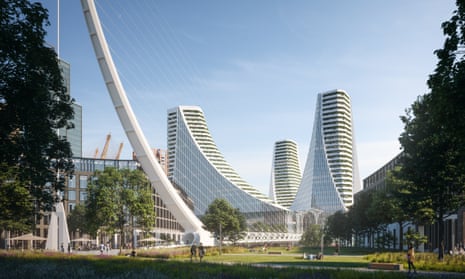The Star Wars theme tune was playing as London’s mayor, Sadiq Khan, arrived, flanked by his deputy mayors for housing and planning, to unveil a glowing perspex model of the capital’s new £1bn landmark on the Greenwich Peninsula. It was a suitably ominous tone to launch the first UK project by Spanish architect Santiago Calatrava, a man who has built a global reputation not only for his gleaming white space-age structures, but for leaving a trail of delays, inflated budgets and costly lawsuits in his wake.
Billed as a new “gateway to Greenwich”, the 130,000 sq metre scheme will provide a new tube and bus station, as well as bars, shops and entertainment venues, crowned with three tapering white towers of offices, hotels and apartments, linked to the riverside by a trademark Calatrava bridge.
“It will be the most beautiful station the country has ever seen,” said Richard Margee, chief executive of Knight Dragon, the Hong Kong-based developer behind the £8.4bn regeneration of the peninsula. “It’s not just a bit of frippery in the middle of the site. The building will really work hard.”
Visitors will emerge from the Underground into a 25 metre-high winter garden, where slender white steel trees will rise to a glazed roof, topped with an opening pyramidal oculus. The three towers will sweep up above, with staggered planted terraces at their base.

“I consider this project a synthesis of what I have done over my entire career,” said the 65-year-old Calatrava. “It has a bridge – I have built 50 of them – and a transport hub – I have built seven of them – and a public space, of which I have done many.”
If it is a summation of his career, it also reads as a series of tired tropes bodged together in one cliched collage. The lumpen towers seem to ape the vogueish work of young Danish architect Bjarke Ingels, while the atrium could be lifted straight from a 1980s suburban shopping plaza, and the bridge – as Calatrava himself hints – repeats the trademark look of the other 50 he has built elsewhere. Here it takes the form of a latticework tube, suspended from a curving mast shaped like a scorpion’s tail, poised ready to strike.
It is the kind of hermetic podium-based architecture familiar to Hong Kong but alien to London, lifting pedestrians up into the air rather than making the streets work at ground level. The site doesn’t need a bridge at all, when a pedestrian crossing would do – but why let that stand in the way of adding an extra Calatrava signature?
The project is part of the Peninsula Central neighbourhood, adjacent to the O2 Arena, which will provide 800 homes, 200 of which will be classed as “affordable”, ie up to 80% of market rent. When Knight Dragon acquired the 150-acre site in 2012, the agreed masterplan was to provide 38% affordable housing across the peninsula, but they successfully negotiated that down, on grounds of financial viability, to 25%, despite receiving a £50m housing grant. James Murray, London’s deputy mayor for housing, hopes to see the level increased to 35%, but given that the developer’s viability argument was based on the costs of the project, that seems unlikely: there are few things more costly than hiring Calatrava.

His World Trade Center transport hub in New York City, shaped like a whale’s rib cage, came in at a staggering $4bn (£3.2bn), twice the original budget, and six years late. His futuristic City of Arts and Sciences complex in his native Valencia ended up costing around €1bn (£860m) over 20 years, almost triple what was originally budgeted. It inspired one of the city’s leftwing politicians to set up a website, calatravatelaclava.com “Calatrava bleeds you dry”), to highlight the architect’s history of cost overruns. Calatrava successfully sued for damages, but the website popped up again as calatravanonoscalla.com (“Calatrava won’t silence us”), and further court action failed to shut it down.
His controversial track record has been meticulously documented in the recent book Queríamos un Calatrava (We Wanted a Calatrava) by journalist Llàtzer Moix, which charts his fall from grace, from attaining god-like status as the Gaudi of our time to being one of the most demonised of architects. It offers a telling insight into how politicians have been star-struck into undertaking projects without detailed budgets being worked out in advance.
Introducing the Greenwich scheme, Khan showered it with praise as an “iconic” building, a “buzzing cultural destination” and “a vote of confidence post-Brexit and shows that London is open to business”. “Now Calatrava has practised around the world,” he joked, “he’s ready to build in London. New York, Lisbon, Bilbao – they were all just a rehearsal for what he’s going to do here.”
That’s one way to look at it. The other is that this project represents a total lack of imagination, the product of a newly isolated country that is desperately limping along, trying to catch up with the rest of the world, happy to take their sloppy seconds and willing to chase overseas investment at any cost to the capital. But at least we’ll be able to say we’ve got a Calatrava bridge.

Comments (…)
Sign in or create your Guardian account to join the discussion